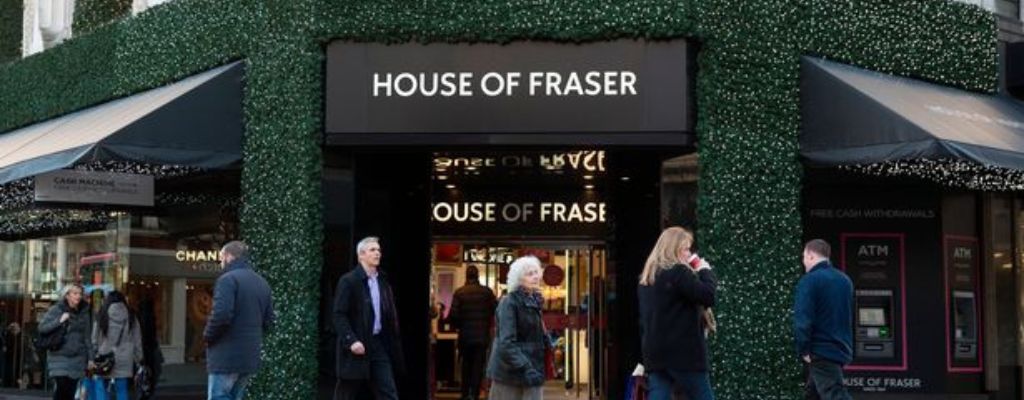
House of Fraser Origins
The House of Fraser is a British department store chain with over 60 stores across the United Kingdom. The company was founded by Hugh Fraser and James Arthur in 1849 as a linen drapery business in Glasgow, Scotland. By 1891, the company had grown to eight stores and was acquired by the Harrods group. In 1957, House of Fraser was floated on the London Stock Exchange. In 1985, the company acquired Harvey Nichols. In 2014, the Chinese conglomerate Sanpower Group purchased an 80% stake in House of Fraser for £480 million.
Who are House of Fraser's competitors?
There are a number of British department stores that compete with House of Fraser, including Selfridges, Harvey Nichols, Harrods, and Fortnum & Mason. These stores all offer a similar range of products and services, but each has its own unique history and identity.
Selfridges is the largest department store in the UK and was founded by American entrepreneur Harry Gordon Selfridge in 1908. The store is known for its lavish displays and luxury goods.
Harvey Nichols is another high-end department store that was established in 1831. The store is particularly popular with fashionistas and has been featured in a number of films and TV shows over the years.
Harrods is the world's largest department store and was founded in 1834. The store stocks an impressive range of products, from food to fashion, and is a popular tourist destination in London.
Finally, Fortnum & Mason is a historic department store that dates back to 1707. The store is famous for its food hall and tea room, and also sells a range of luxury goods.
House of Fraser Timeline
1849:
House of Fraser is founded by Hugh Fraser and James Arthur in Glasgow, Scotland. The company starts out as a small drapery shop.
1891:
The first House of Fraser store opens on London's Oxford Street.
1928:
House of Fraser acquires the iconic Harrods department store.
1985:
The company is floated on the London Stock Exchange.
2014:
after going through a number of ownership changes, House of Fraser is acquired by Chinese conglomerate Sanpower for £480 million.
The History of House of Fraser (19th century)
In 1849, Hugh Fraser and James Arthur purchased a small drapery shop on the corner of Argyle Street and Buchanan Street in Glasgow. The company grew steadily, and by 1856 they had opened a second store on Edinburgh's Princes Street. The success of the Edinburgh store led to a rapid expansion, and by 1895 there were stores in Manchester, Liverpool, Leeds, Birmingham, and London.
The early 20th century was a period of great growth for House of Fraser. In 1909 they acquired the famous London department store Dickins & Jones, and in 1920 they took over the iconic Scottish department store Arnott's. By 1930 House of Fraser had become one of the largest department store groups in the UK, with a total of 36 stores across the country.
The company continued to grow throughout the rest of the 20th century, acquiring several more well-known department stores including Selfridges (1949), Harrods (1959), and Harvey Nichols (1972). In 1985 House of Fraser was taken over by the Egyptian conglomerate Casterbridge Group, but this proved to be unsuccessful and the company was sold again just four years later.
In 1994 House of Fraser was floated on the London Stock Exchange, and in 2006 it was acquired by Baugur Group, an Icelandic investment company. Baugur went into administration in 2009 during the global financial crisis, and as a result House of Fraser was sold to Hamley's owner Nanjing Xinjie
The History of House of Fraser (20th and 21st century)
In the early 20th century, House of Fraser was founded by Hugh Fraser and James Arthur in Glasgow, Scotland. The first store was opened in 1849 on the corner of Argyle Street and Buchanan Street. By the end of the 19th century, the company had grown to eight stores across Scotland and England.
In 1952, the company was floated on the London Stock Exchange. In 1957, House of Fraser acquired Harrods, which became its flagship store. In 1959, House of Fraser also acquired Harvey Nichols.
The late 20th century saw House of Fraser expand rapidly, with the opening of new stores across the UK and Ireland. In 1985, the company acquired Jenners, a Scottish department store chain. In 2006, House of Fraser was taken over by Baugur Group, an Icelandic investment company. However, Baugur went into administration in 2009 during the global financial crisis.
In 2014, House of Fraser was acquired by Nanjing Xinjiekou Department Store Co., Ltd., a Chinese conglomerate. The 21st century has seen House of Fraser continue to grow, with new stores opening in China and Europe.

Timeline : The History Of House Of Fraser
1849 - Hugh Fraser and James Arthur set up a drapery business in Glasgow, Scotland.
1856 - The first House of Fraser store opens in Glasgow.
1912 - House of Fraser merges with Harvey Nichols.
1920s – House of Fraser expands across the UK, opening stores in London, Manchester, Birmingham and Cardiff.
1930s – The company diversifies into homeware and furniture with the acquisition of several department stores.
1940s – House of Fraser is appointed official wardrobe supplier to the British armed forces during World War II.
1950s – The company goes public and begins to expand internationally with the opening of stores in Canada, Australia and New Zealand.
1960s – House of Fraser acquires several iconic British brands including Harrods, Selfridges and Liberty.
1970s – The company opens its first overseas store in Dubai.
1980s – House of Fraser suffers from a series of takeover attempts. In 1985, the Egyptian businessman Mohamed Al-Fayed purchases the company.
1990s – Under Al-Fayed’s ownership, House of Fraser undergoes a major refurbishment program and expands into Asia with the opening of stores in Hong Kong and Singapore.
2000s – In 2006, Al-Fayed sells House of Fraser to the Icelandic investment group Baugur for £950 million (US$1.8 billion).
Fashion Hallmarks from the 1920s to date
Fashion is always changing, but there are certain hallmarks that have remained throughout the years. Here are some of the most iconic fashion moments from the last century:
1920s – Flapper style dress with dropped waist and fringe
1930s – Hollywood glamour with bias-cut dresses and shoulder pads
1940s – Utility chic with simple, tailored silhouettes
1950s – Feminine hourglass silhouette with full skirts and nipped-in waists
1960s – Mod style with shift dresses and miniskirts
1970s – Boho chic with maxi dresses and wide-leg trousers
1980s – Power dressing with sharp suits and big hair
1990s – Grunge style with plaid shirts and ripped jeans
2000s – Sexy, streamlined style with low-rise jeans and fitted tops
